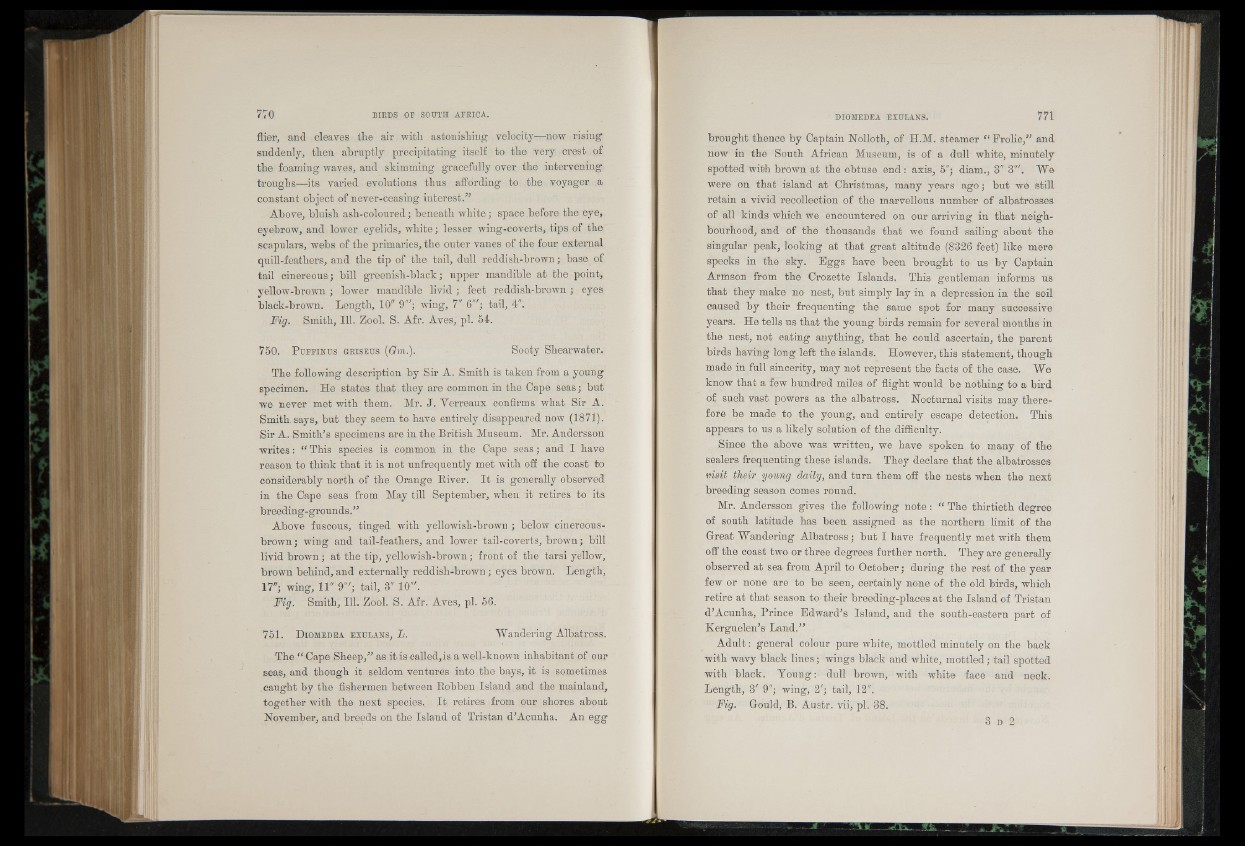
flier, and cleaves the air with astonishing velocity—now rising
suddenly, then abruptly precipitating itself to the very crest of
the foaming waves, and skimming gracefully over the intervening
troughs—its varied evolutions thus affording to the voyager a
constant object of never-ceasing interest.”
Above, bluish ash-coloured; beneath white; space before the eye,
eyebrow, and lower eyelids, white; lesser wing-coverts, tips of the
scapulars, webs of the primaries, the outer vanes of the four external
quill-feathers, and the tip of the tail, dull reddish-brown; base of
tail cinereous; bill greenish-black; upper mandible at the point,
yellow-brown; lower mandible livid; feet reddish-brown; eyes
black-brown. Length, 10" 9"'; wing, 7" 6"'; tail, 4".
Fig. Smith, 111. Zool. S. Afr. Aves, pi. 54.
750. P u f f in u s g riseus (Grn.). ■ Sooty Shearwater.
The following description by Sir A. Smith is taken from a young
specimen. He states that they are common in the Cape seas; but
we never met with them. Mr. J. Yerreaux confirms what Sir A.
Smith, says, but they seem to have entirely disappeared now (1871).
Sir A. Smith’s specimens are in the British Museum. Mr. Andersson
writes: “ This species is common in the Cape seas; and I have
reason to think that it is not unfrequently met with off the coast to
considerably north of the Orange River. It is generally observed
in the Cape seas from May till September, when it retires to its
breeding-grounds.”
Above fuscous, tinged with yellowish-brown ; below cinereous-
brown ; wing and tail-feathers, and lower tail-coverts, brown; bill
livid brown; at the tip, yellowish-brown; front of the tarsi yellow,
brown behind, and externally reddish-brown; eyes brown. Length,
17"; wing, 11" 9"'; tail, 3'' 10'".
Fig. Smith, 111. Zool. S. Afr. Aves, pi. 56.
751. D io m e d e a exulatsts, L. Wandering Albatross.
The “ Cape Sheep,” as it is called, is a well-known inhabitant of our
seas, and though it seldom ventures into the bays, it is sometimes
caught by the fishermen between Robben Island and the mainland,
together with the next species. It retires from our shores about
November, and breeds on the Island of Tristan d’Acunha. An egg
brought thence by Captain Nolloth, of H.M. steamer “ Frolic,” and
now in the South African Museum, is of a dull white, minutely
spotted with brown at the obtuse end: axis, 5"; diam., 3" 3"'. We
were on that island at Christmas, many years ago; but we still
retain a vivid recollection of the marvellous number of albatrosses
of all kinds which we encountered on our arriving in that neighbourhood,
and of the thousands that we found sailing about the
singular peak, looking at that great altitude (8326 feet) like mere
specks in the sky. Eggs have been brought to us by Captain
Armson from the Crozette Islands. This gentleman informs us
that they make no nest, but simply lay in a depression in the soil
caused by their frequenting the same spot for many successive
years. He tells us that the young birds remain for several months in
the nest, not eating anything, that he could ascertain, the parent
birds having long left the islands. However, this statement, though
made in full sincerity, may not represent the facts of the case. We
know that a few hundred miles of flight would be nothing to a bird
of such vast powers as the albatross. Nocturnal visits may therefore
be made to the young, and entirely escape detection. This
appears to us a likely solution of the difficulty.
Since the above was written, we have spoken to many of the
sealers frequenting these islands. They declare that the albatrosses
visit their young daily, and turn them off the nests when the next
breeding season comes round.
Mr. Andersson gives the following note: “ The thirtieth degree
of south latitude has been assigned as the northern limit of the
Great Wandering Albatross; but I have frequently met with them
off the coast two or three degrees further north. They are generally
observed at sea from April to October; during the rest of the year
few or none are to be seen, certainly none of the old birds, which
retire at that season to their breeding-places at the Island of Tristan
d’Acunha, Prince Edward’s Island, and the south-eastern part of
Kerguelen’s Land.”
Adult: general colour pure white, mottled minutely on the back
with wavy black lines; wings black and white, mottled; tail spotted
with black. Young: dull brown, with white face and neck.
Length, 3' 9"; wing, 2'; tail, 12".
Fig. Gould, B. Austr. vii, pi. 38.